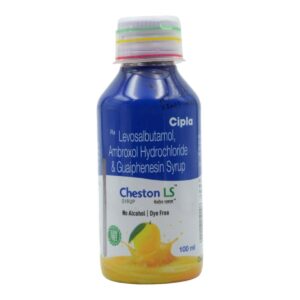CHLORPHENIRAMINE + BROMHEXINE + LEVOSALBUTAMOL
Chlorpheniramine: Chlorpheniramine is a first-generation antihistamine drug that is used to treat allergic conditions such as hay fever, allergic rhinitis, hives, and allergic conjunctivitis. It is also sometimes used to relieve symptoms of the common cold and to manage symptoms of motion sickness.
The mechanism of action of Chlorpheniramine involves blocking the effects of histamine, a substance released by the body during an allergic reaction. By blocking histamine receptors, Chlorpheniramine helps to reduce or prevent symptoms such as sneezing, itching, watery eyes, and runny nose.
The usual recommended dose of Chlorpheniramine for adults is 4 mg every 4 to 6 hours, up to a maximum of 24 mg in a 24-hour period. For children, the recommended dose depends on their age and weight, and it is important to follow the instructions of a healthcare professional or the medication’s packaging.
Like other antihistamines, Chlorpheniramine can cause some side effects. Common side effects may include drowsiness, dizziness, dry mouth, blurred vision, constipation, and urinary retention. These side effects may be more pronounced in older adults. It is important to avoid driving or operating machinery if experiencing drowsiness or dizziness. Some individuals may also experience an allergic reaction to Chlorpheniramine, characterized by rash, itching, swelling, severe dizziness, or difficulty breathing. In such cases, immediate medical attention should be sought.
As with any medication, it is essential to consult with a healthcare professional or pharmacist before using Chlorpheniramine, especially if you have any underlying medical conditions or are taking other medications, as there may be potential drug interactions or contraindications.
Bromhexine: Bromhexine is a medication used to help clear mucus and phlegm from the respiratory tract. It is commonly used in the treatment of conditions such as chest congestion, bronchitis, and chronic obstructive pulmonary disease (COPD).
The primary mechanism of action of Bromhexine is to stimulate the production of thinner and less viscous mucus in the respiratory tract. It does so by increasing the secretion of serous mucus from the submucosal glands and reducing the viscosity of the mucus. This helps to facilitate the clearance of mucus from the airways, making it easier to cough up and expel.
The typical recommended dose of Bromhexine is 8-16 mg taken three times a day, depending on the severity of symptoms. The medication is usually taken orally in the form of tablets or syrup. It is important to follow the instructions given by the healthcare professional or that are mentioned on the package leaflet.
Like any medication, Bromhexine may cause some side effects. The most common side effects include nausea, vomiting, stomach upset, diarrhea, and headache. Some people may also experience skin rashes or allergic reactions. If any of these side effects persist or worsen, it is advisable to seek medical attention.
Certain precautions should be taken into consideration before using Bromhexine. It is not recommended for individuals with known hypersensitivity to the drug or those who have stomach ulcers. It is also important to inform the healthcare professional about any other medications being taken, as Bromhexine may interact with certain drugs.
In conclusion, Bromhexine is a medication used to thin and clear mucus from the respiratory tract. It does so by increasing mucus secretion and reducing its viscosity. The typical dose of Bromhexine is 8-16 mg three times a day. While side effects may occur, they are generally mild and temporary. It is always best to consult with a healthcare professional before starting any new medication.
Levosalbutamol: Levosalbutamol, also known as levalbuterol, is a selective beta-2 adrenergic agonist. It is commonly used in the treatment of asthma and chronic obstructive pulmonary disease (COPD) to relieve symptoms such as wheezing, shortness of breath, and chest tightness.
The main mechanism of action of levosalbutamol is the relaxation of the smooth muscles in the airways, which helps to open up the blocked or constricted air passages. By binding to the beta-2 adrenergic receptors in the airway smooth muscle, levosalbutamol activates a cascade of intracellular events leading to bronchodilation.
Levosalbutamol is typically administered via an inhaler or nebulizer. The recommended dose for adults and adolescents (12 years and older) is usually 0.63 mg to 1.25 mg every 4 to 6 hours, with a maximum daily dose of 2.5 mg. The specific dosage may vary depending on the severity of the condition and individual patient response.
As with any medication, there may be potential side effects associated with levosalbutamol. Common side effects include rapid heartbeat, nervousness, headache, dizziness, tremor, muscle cramps, and sleep disturbances. In rare cases, levosalbutamol can cause allergic reactions such as skin rash, itching, swelling, or difficulty breathing. If any of these side effects occur, it is important to seek medical attention.

